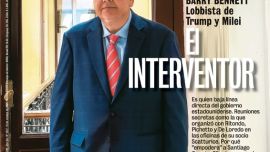Yesterday we moved one year closer to the centenary of the 1930 coup with its 94th anniversary. Only one of half a dozen major coups in the past century, the 1930 coup nevertheless stands out as being widely considered the great watershed in Argentine history as the start of a decline continuing until this day. Yet this verdict is not unanimous – President Javier Milei, for one, insists that Argentina’s problems began even earlier in 1916 when universal manhood suffrage (Ley Saenz Peña) was introduced. Not many subscribers to that implicitly anti-democratic view with stronger rivals to 1930 as the key turning-point – ever since Peronism came to power (or Kirchnerism with a good half a century between them), the 1976 coup, the 1989 hyperinflation and the 2001-2002 meltdown being perhaps the main ones.
Analysts of Argentina’s decline understandably focus on the whys but there is a strong case for saying that they are inextricably intertwined with the whens, on which this column will centre as the crux of the matter. A chronological sequence is the most logical approach for listing the whens, while not the best.
Almost alone as Milei might be in his view that Argentina went wrong when it took a democratic turn in the road (bizarre for a man with the highest percentage of votes in the four decades since democracy returned), a devil’s advocate might find at least a couple of arguments in his support.
The first would be not so much against democracy as such as midterms – when governments already have to start worrying about renewing voter endorsement only a few months after going to the polls, any long-term development strategies fly out of the window. Not that the various military governments since 1930 free of these restraints have done much better.
The other belongs more to Milei’s economic sphere than politics – many people think the double-digit negative growth of 2002 was unprecedented but it had already been experienced in 1914. Not altogether surprising that the outbreak of world war and the collapse of international trade should hit a major meat and wheat exporter like Argentina so hard but this disruption seems to have done more to hasten the exit of the pre-democratic regime (a factor often ignored) than to derail any economic model permanently.
But even if the 1930 coup 94 years ago yesterday shredding the institutional fabric and inaugurating half a century of military-civilian alternation is mostly deplored by progressive spirits (especially Radicals), Milei might well have more reasons to consider it the decisive turning-point than his choice of 1916. For economic rather than political or institutional reasons. The import substitution which Milei rubbished on Industry Day last Monday as banishing Argentina from world trade began then – the reaction of a model which had not changed significantly with the shock of World War I to a second jolt in the form of the Great Depression as from 1929. Perhaps inevitable with a third of international trade obliterated in the 1930s but the temporary became permanent – the urban sprawl of a Greater Buenos Aires industrial belt sucking the hinterland dry of population and surplus value offered the ideal hotbed for populism, crony capitalism and other ills. A model enshrined by the creation in 1935 of the Central Bank which Milei has pledged to dynamite. So why aren’t the 1930s the “infamous decade” for him just as much as for liberal democrats and leftists?
The military-civilian alternation between 1930 and 1983 included a hybrid – the elected dictatorship of an Army colonel. Half the country or more has no hesitation in blaming Peronism for Argentina’s decline and given that the downhill slide began around 1950 with Juan Domingo Perón in the presidency, the movement would stand guilty as charged with its nationalism and populism impoverishing both the nation and the people.
The broad brush of history would say that they are right but this columnist has a couple of doubts. To gauge the damage done by Peronism, it is necessary to look not only at the first Perón presidencies but at what came afterwards and the two decades after the regime’s 1955 downfall showed a socio-economic stability, a prosperous image and cultural vitality at all odds with the extreme political volatility – Mafalda’s Argentina. With over half the population impoverished and 18 percent destitute, analysts eye the sociology of those years with envy – 70 percent middle-class and 21 percent working-class with just four percent below the poverty line and five percent affluent. This columnist has a couple of doubts about these figures too – if the middle class more than trebled the working class, how come Peronism always won 40 to 60 percent of the vote? And looking at the documentary footage of the utter misery of Diego Maradona’s Villa Fiorito childhood in the 1960s, did this idol of the masses really have the extreme misfortune to be born in such a tiny minority of four percent? Another doubt is the fact that while Perón pioneered rifling the pension funds, they remained in surplus until 1980.
The latter year saw the country under the junta coming into power in the 1976 coup, the great rival of 1930 as the villain of Argentine history. Forget about the thousands of missing, the atrocities and a lost war (although we never should) and look at the dictatorship through Milei’s economic prism and it remains a horror – a quintupled foreign debt, quadrupled poverty, local industry and the trade balance sacrificed to an overvalued peso and we could go on. The massacre of an artificially protected industry could have been a Schumpeterian “creative destruction” modernising Argentina but not even that.
Not much space left for the most recent half-century. The other three candidates for turning-point – the 1989 hyperinflation, the 2001-2002 meltdown and Kirchnerism – come less to mind, partly because the ups and downs partially conceal the overall decline with each having their antithesis. The 1989 hyperinflation shattered the austral and the Radicals but not the peso and Peronism. Since then we have seen the mirage of dollar-peso parity with its promise of modernisation come to a bad end with the 2001-2002 meltdown, followed by a global commodity boom feeding a surrealistic Kirchnerism now in retreat. Since Néstor Kirchner, each presidential term has been worse than the previous (even when the same person) with the jury still out on this administration so people lose the sense of any turning-point.
Having run through the whens, no space for the whys except to say that each different when leads to different whys.




















Comments